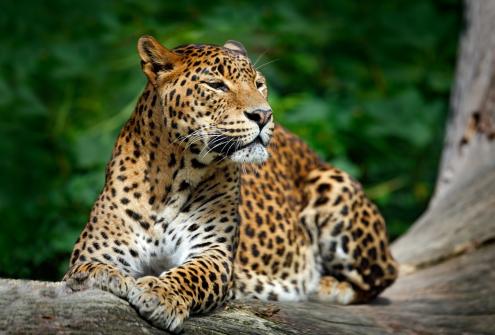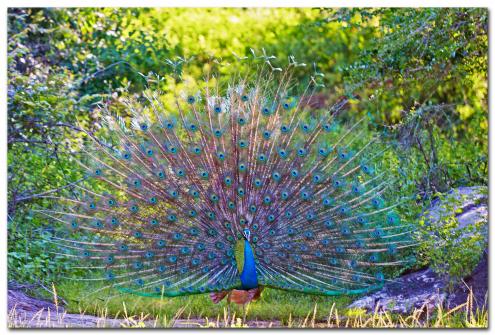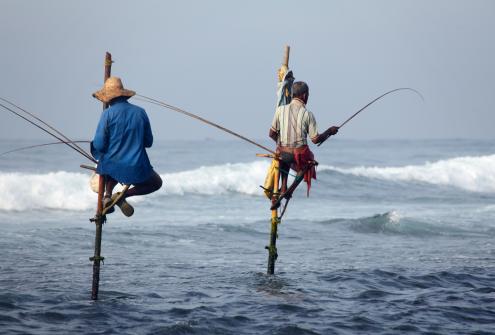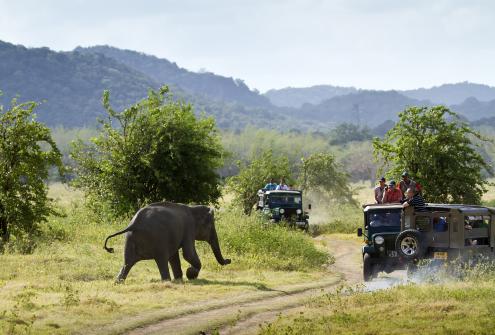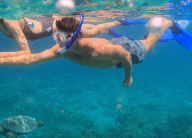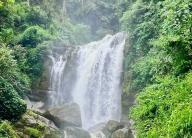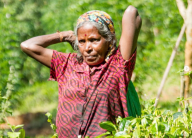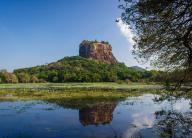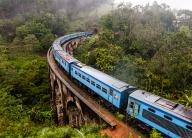Best Time to Visit: All year round ; ill advised: September
Udawalawe
The National Park was created to provide a sanctuary for wild animals displaced by the construction of the Udawalawe reservoir on the Walawe River, as well as to protect the catchment of the reservoir. The reserve covers 30,821 hectares (119.00 sq mi) of land area and was established on 30 June 1972. Before the designation of the national park, the area was used for shifting cultivation (chena farming). The farmers were gradually removed once the national park was declared. The park is 165 kilometres (103 mi) from Colombo. Udawalawe is an important habitat for water birds and Sri Lankan Elephants. It is a popular tourist destination and the third most visited park in the country.
Udawalawe is an important habitat for Sri Lankan Elephants, which are relatively easy to see in its open habitats. Many elephants are attracted to the park because of the Udawalawe reservoir, with a herd of about 250 believed to be permanently resident. The Udawalawe Elephant Transit Home was established in 1995 for the purpose of looking after abandoned elephant calves within the park. A total of nine calves, on two occasions in 1998 and 2000, with another eight calves in 2002, were released in the park when old enough to fend for themselves.
The Rusty-spotted Cat, Fishing Cat and Sri Lankan Leopard are members of the Felidae family present in Udawalawe. The Sri Lankan Sloth Bear is seldom seen because of its rarity. Sri Lankan Sambar Deer, Sri Lankan Axis Deer, Indian Muntjac, Sri Lankan Spotted Chevrotain, Wild Boar and Water Buffalo are among other mammal species. Golden Jackal, Asian Palm Civet, Toque Macaque, Tufted Grey Langur and Indian Hare also inhabit the park.
Udawalawe is also a good bird watching site. Endemics such as Sri Lanka Spurfowl, Red-faced Malkoha, Sri Lanka Grey Hornbill, Brown-capped Babbler, and Sri Lanka Jungle fowl are among of the breeding resident birds. White Wagtail and Black-capped Kingfisher are rare migrants. A variety of water birds visit the reservoir, including cormorants, the Spot-billed Pelican, Asian Openbill, Painted Stork, Black-headed Ibis and Eurasian Spoonbill, The open parkland attracts birds of prey such as White-bellied Sea Eagle, Crested Serpent-eagle, Greyheaded Fish Eagle, Booted Eagle, and Changeable Hawk-eagle. Land birds are in abundance, and include Indian Roller, Indian Peafowl, Malabar Pied Hornbill and Pied Cuckoo.
Udawalawe Transit Home
The Udawalawe Elephant Transfer Home is a facility within Udawalawe National Park in Sri Lanka that was established in 1995 by the Sri Lanka Department of Wildlife Conservation. Its primary objective is to rehabilitate orphaned elephant calves for ultimate release back into the wild and is a 20 minute drive away from Udawalawe National Park. Here, orphaned or sick elephants are fed and cared for until they are strong enough to be returned to the wild. The centre allows you to visit at the feeding times of 06:00, 09:00, 12:00, 15:00 and 18:00. From behind a barrier you can watch the elephants ambling along behind a keeper, into the compound where they will be fed milk through plastic hoses with funnels attached, some stamping and trumpeting with impatience.
Yala National Park
This park is famous for its high density of leopards, perhaps the highest in the world. You are also sure to see elephants – grumpy loan males during the dry months and large herds in the wet season. Sloth bears are also a big draw. You will also see mammal such as wild boars, several species of deer and wild buffalo. There is a plethora of reptilian species and platoons of crocodiles. As is common in Sri Lanka there is a huge diversity of stunning birdlife including migratory species such as the flamingo. It is also one of the few places in the world where the severely endangered black necked stork can still be seen. The uniqueness of the park is the sheer diversity of the habitat: dense jungles suddenly gives way to lagoons and open plain areas and the park has a simply beautiful sea front. Huge, stark boulders dominate the horizon and the elegant, languorous leopard can often be seen basking atop the sun baked rock.
Located in the wild south-east part of the island, this region is a haven for flora and fauna and excellent game. The beaches are backed by large sand dunes giving rise to lagoons, woodland and scrub bush. The premier wildlife location in Sri Lanka, Yala offers an almost African safari experience as well as an important Buddhist temple site. On game drives by jeep, one can usually view wild elephant, buffalo and boar, huge monitor lizards, macaque monkeys and many rare and endemic bird species: it is also the best place in south Asia to spot the elusive leopard, often seen and admired. Lazing on a treetop, blending in perfectly with its surroundings, the big cat is almost invisible, yet the absence of tigers in Sri Lanka makes for a leopard with real attitude. Usually tagged „Prince of the Night‟, this cat is well out of its normally nocturnal closet. Confident, it will stroll in the open by day, to every ecotourist’s delight. There are believed to be about 600 leopards across Sri Lanka today, mostly in the protected parks and reserves. Yala National Park has one of the highest recorded densities of leopards in the world.
Sinharaja Forest Reserve
It is the last viable remnant of Sri Lanka's tropical lowland rainforest; over 60% of the trees are endemic and many of these are rare; and there are 21 endemic bird species as well as a number of rare insects, reptiles and amphibians.
Bundala National Park Covering an area of 6216 hectares the park is situated about 250 km South East of Colombo in the Hambantota District. This is in the heart of the hot and dry zone associated with the Southern coastal areas. With sand dunes bordering the coastline, the vegetation consists of dry thorny scrublands and lagoons.
The park offer a vast bio diversity, with 383 plant species, including 6 endemic and 7 species which are considered to be at threat within Sri Lanka. In addition it is home to 32 different species of mammal of which 5 are classified as threatened. With a combination of wetlands and salty lagoons, the park has a rich bird life with some 197 species spotted living in and migrating via the park and is considered as an internationally important wintering ground for migratory water birds. Large flocks of Greater Flamingo are one of the more impressive sights.
The park contains a small population of elephants; in addition on the rocky outcrops, leopards can be seen hunting for Spotted, Sambar & barking deer; the occasional Sloth Bear roams & equally the lagoons and freshwater areas contains a wide variety of estuarine & Mugger fresh water crocodiles as well as a variety of lizards.




